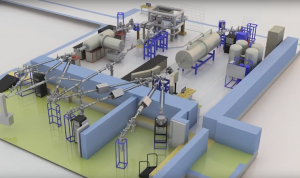Presented By: Michigan Engineering
Michigan Ion Beam Laboratory Open House
Tour world class materials testing facility

The Michigan Ion Beam Laboratory (MIBL) team at the University of Michigan invites you to a laboratory open house from 3:00 to 6:00 pm, during which you can tour the newly-upgraded MIBL laboratory.
With the addition of a third accelerator, MIBL is now the premier facility for conducting experiments on nuclear reactor materials with ion beams worldwide. The accelerators shoot beams of ions, or charged particles, into materials to find out how well they would hold up inside a nuclear reactor.
Using three beams at once, the lab can mimic all types of radiation damage that occur inside a reactor. Hydrogen and helium beams build tiny cavities inside the material's structure, similar to the hydrogen and helium that is produced in nuclear reactor materials due to radiation. The other beam knocks atoms out of place, emulating the long exposure radiation in a reactor.
The laboratory expansion was funded by the Department of Energy, TerraPower, the Electric Power Research Institute, the College of Engineering and the Department of Nuclear Engineering and Radiological Sciences.
With the addition of a third accelerator, MIBL is now the premier facility for conducting experiments on nuclear reactor materials with ion beams worldwide. The accelerators shoot beams of ions, or charged particles, into materials to find out how well they would hold up inside a nuclear reactor.
Using three beams at once, the lab can mimic all types of radiation damage that occur inside a reactor. Hydrogen and helium beams build tiny cavities inside the material's structure, similar to the hydrogen and helium that is produced in nuclear reactor materials due to radiation. The other beam knocks atoms out of place, emulating the long exposure radiation in a reactor.
The laboratory expansion was funded by the Department of Energy, TerraPower, the Electric Power Research Institute, the College of Engineering and the Department of Nuclear Engineering and Radiological Sciences.